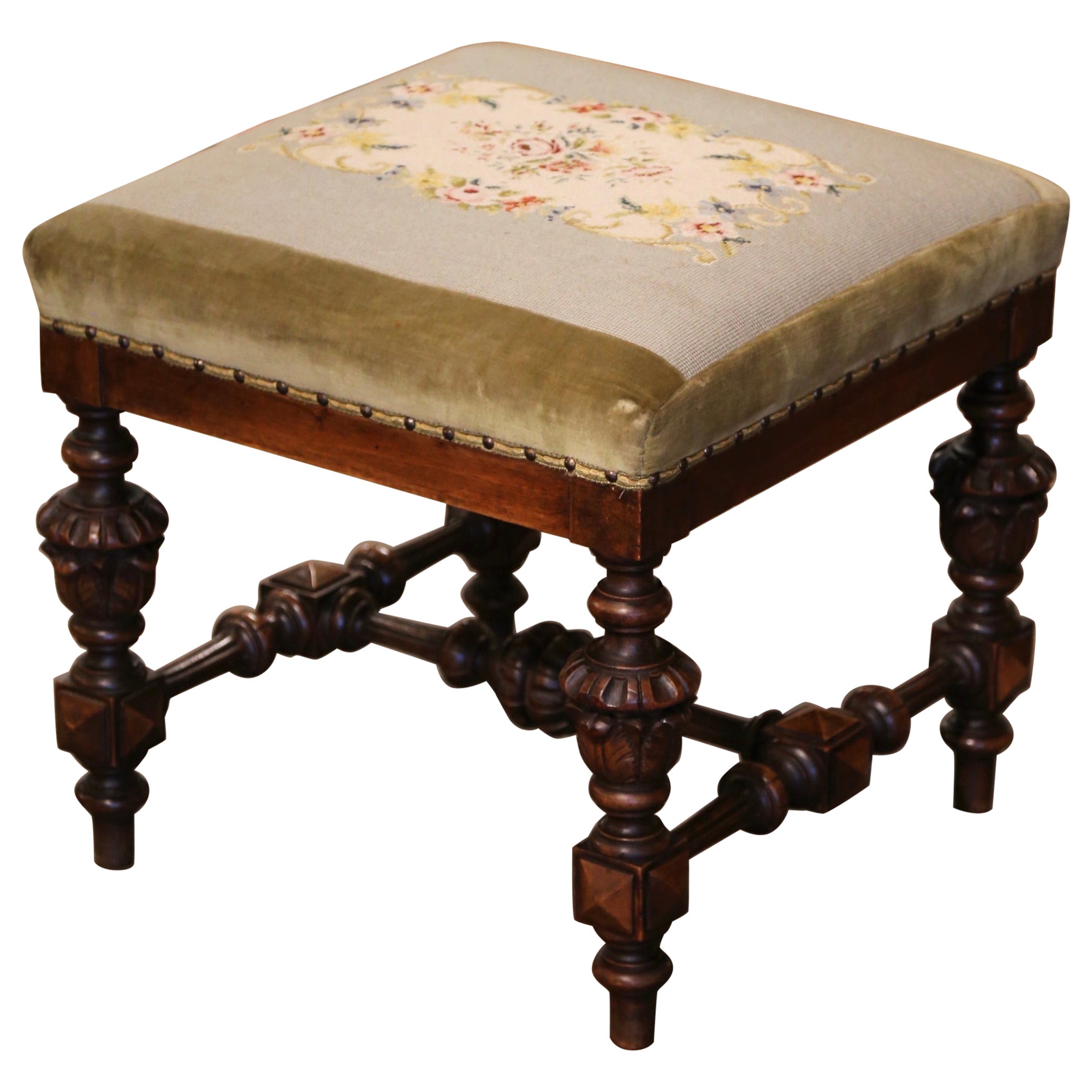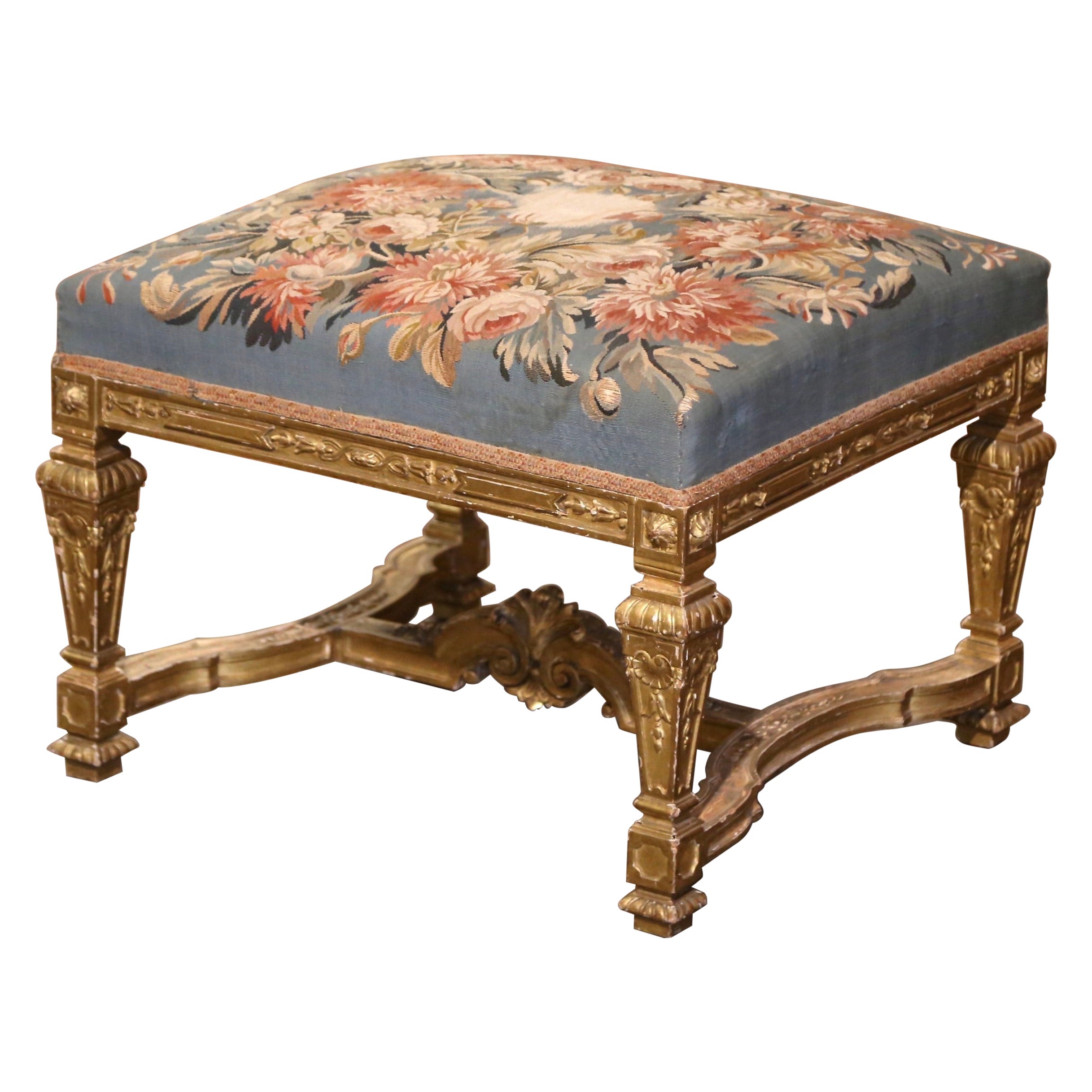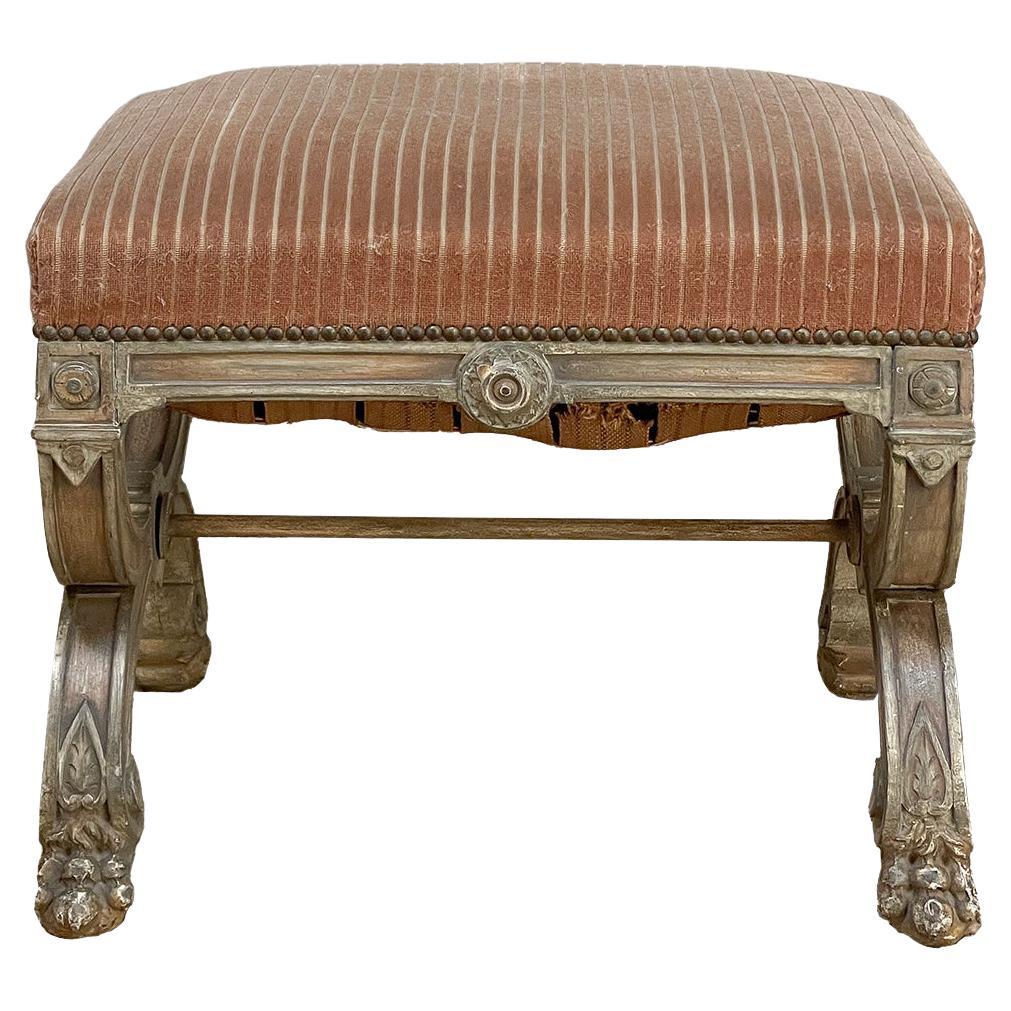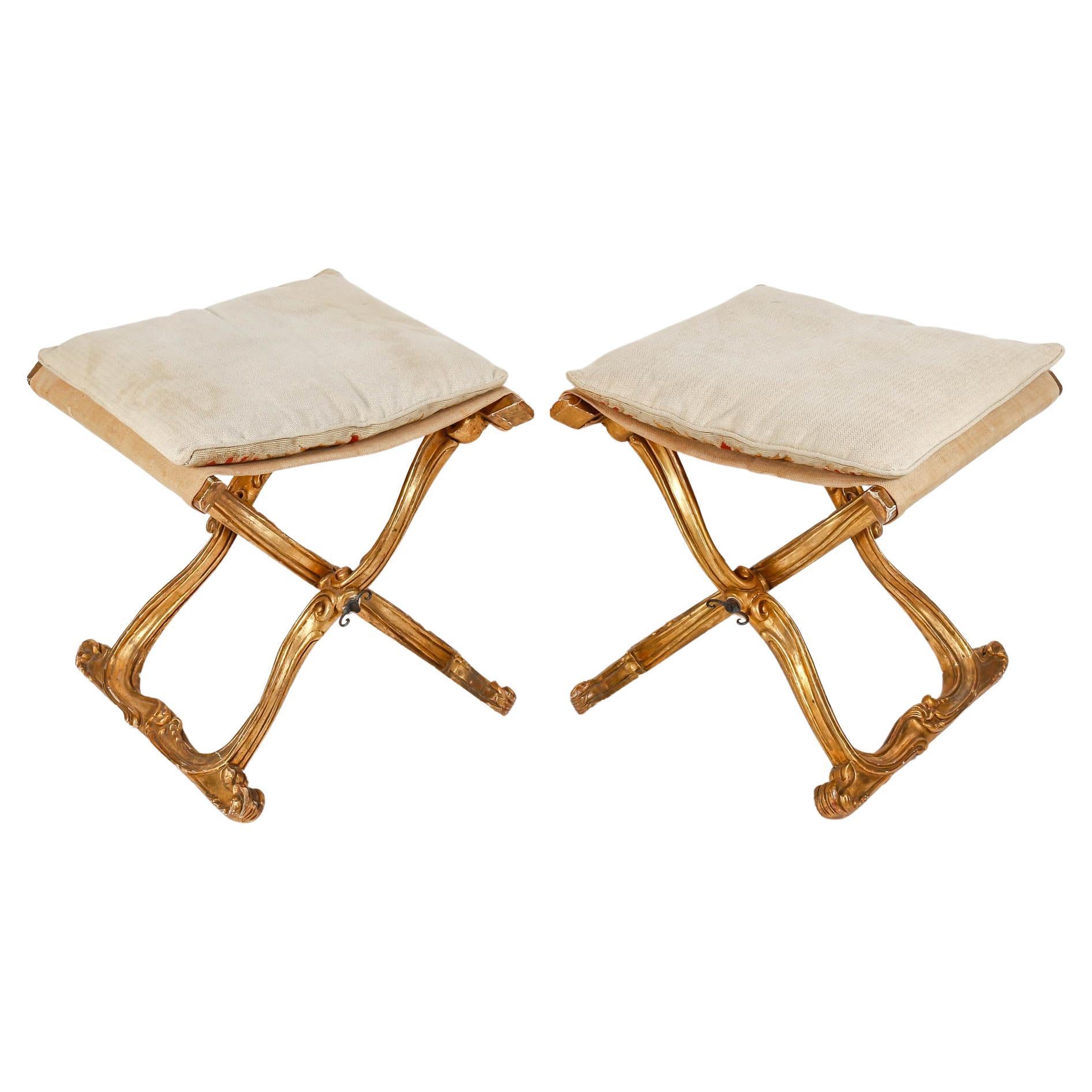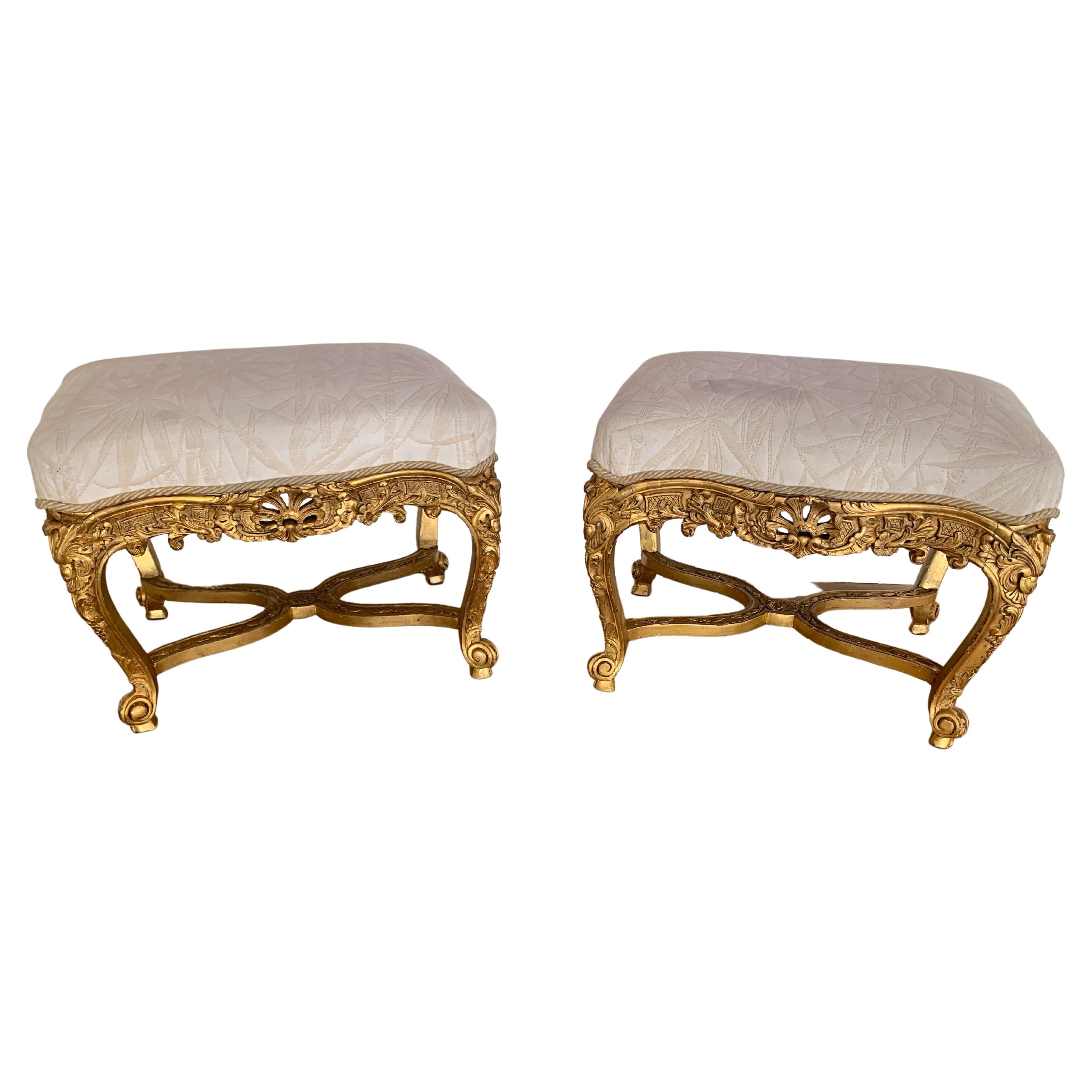Items Similar to A French 19th Century Pair of Louis XIV Style Stools
Want more images or videos?
Request additional images or videos from the seller
1 of 11
A French 19th Century Pair of Louis XIV Style Stools
About the Item
A French 19th Century Pair of Large Rectangular Stools natural and carved wood.
The 4 sheaths feet carved and linked by a stretcher.
Louis XIV Style
Napoléon III Period
Circa 1880
Used Petit Point Tapestry Upholstery
If the stool played a great role at the court of Louis XIV, it was also the pretext of a war... that of the stools precisely, recounted by Saint-Simon. The Duchesses fought and the Duchesse became a seat with very curious forms.
There were benches and chairs, then armchairs, not to mention stools. A seat dear to the duchesses. Some fought for one, to sit in the presence of the queen. Standing, while others, sometimes cousins, were seated, was intolerable. The Duke of Saint-Simon was pleased to recount the «war of stools». This one was provoked by Mme de Chevreuse who sat, without any way, before Queen Anne of Austria, in the Val de Grâce, as well as from time to time, her sister-in-law, Mme de Guéméné. She was to remain standing at the Palais Royal: “… she sees no difference between the Val-de-Grâce and the Palais-Royal, nor why her sister-in-law, who sat in front of the entire Queen’s court in one place, would stand in another…” Mme de Chevreuse thus succeeded in «tearing off the stool in full everywhere for the prin-cess of Guéméné». The stool played a great role at the court of Louis XIV, ambassadors and courtiers were not unaware that the right to the armchair, the «back chair» or the stool was strictly codified.
- Dimensions:Height: 14.18 in (36 cm)Width: 24.81 in (63 cm)Depth: 18.9 in (48 cm)Seat Height: 18.9 in (48 cm)
- Sold As:Set of 2
- Style:Louis XIV (In the Style Of)
- Materials and Techniques:
- Place of Origin:
- Period:
- Date of Manufacture:1880
- Condition:Wear consistent with age and use.
- Seller Location:Saint-Ouen, FR
- Reference Number:1stDibs: LU2612339358762
About the Seller
4.9
Vetted Seller
These experienced sellers undergo a comprehensive evaluation by our team of in-house experts.
1stDibs seller since 2017
57 sales on 1stDibs
Typical response time: 2 hours
- ShippingRetrieving quote...Ships From: Saint-Ouen, France
- Return PolicyA return for this item may be initiated within 2 days of delivery.
More From This SellerView All
- A French 19th Century Pair of Louis XVI Style Large Curule StoolsBy Georges Jacob, Maison JansenLocated in Saint-Ouen, FRA French 19th Century Pair of Large Rectangular Curule Stools Gilt and carved wood, decorated with interlace frieze, acanthus leaves and rosaces The 4 feet linked by a gadrooned stretcher. Louis XVI Style Napoléon III Period In the manner of Georges Jacob (1739-1814) Attributed to Maison Jansen Circa 1900 Used Petit Point Tapestry Upholstery Maison Jansen, the French luxury: Opulence, refinement, audacity of style marriages… so many words agree with Maison Jansen. Through this name, a whole era sounds like a reminder of a certain French chic… Some names evoke immutable images, atmospheres... Like Jansen, for example. Let’s close our eyes… The 1960s and 1970s are at their peak. France is doing well. It is a country of full employment where everything seems possible. Within the international Jet Set, a carefree crowd of movie stars, public figures, literary idols and crowned heads, we love the Maison Jansen, its taste for styles struck with a good quality exuberance, and its brilliant side. It all began in 1880, when the Dutchman Jean Henri Jansen founded the epon-ymous house in Paris. Jansen is part of the continuity of these world-famous furniture manufacturers and companies that operated under the Second Empire and at the time of the Universal Exhibitions, as the ‘Escalier de Cristal’ teaches. At that time, the Union Centrale des Beaux-Arts appliqués à l'Indus-trie and the Société du musée des Arts Décoratifs merged to form the Union Centrale des Arts Décoratifs. Supported by both gallery owners, collectors and manufacturers, this organi-zation gives the «la» to the whole profession, and in the prevailing politico-ideological slump (France was defeated by Prussia in 1871 and Napoleon III is in exile), the ‘Union Centrale des Art Décoratifs’ focuses production on the celebration of past styles. While this nostalgia evokes memories of an era that we imagine more stable, an innovative exoticism will be all the rage: the reign of Turkish style and Japonisme. The Jansen house masterfully rushed into the «exotic» trend, but quickly de-veloped a style derived from the ornamental splendor of the eighteenth, then a little later, so-called «imperial» styles mainly intended for royal families. Af-ter the First World War, J.H Jansen was joined by the cartoonist Albert Cazes, by Stéphane Boudin and by Pierre Delbée, who successively directed the house when it disappeared in 1929. At the end of the Kennedy era, Boudin complete-ly redecorated the White House, at the request of the First Lady, Jackie, who had fallen in love with his work after discovering it at Malmaison. In 1971, Jansen joined forces with Leleu-Deshays and continued its quest for excellence. From 1969 to 1979, the dandy decorator Serge Robin took the reins of the house, granting it an eclectic and luxurious style: he revisited the great eras of French art, from the Renaissance to Louis XVI, by modernizing them with more contemporary pieces in Plexiglas or wrought iron. His recomposed and sophisticated style met with resounding success. When Jackie Kennedy, who became the wife of the great Greek shipowner Aristotle Onassis, moved to France, the young architect married Louis XVI-style furniture to modernist designs from the 1950s. When the Shah of Iran decided to celebrate the 250th anniversary of the Per-sian Empire in 1971, Serge Robin and his teams turned to the grandiose and ephemeral setting of Persepolis. A hundred semi-trailers then left the work-shops on Rue Saint-Sabin to reach Tehran. At the same time, Princess Soraya of Iran commissioned her a sumptuous palace for Avenue Montaigne, the princes Faisal bin Fahd of Arabia and Mubarak Al-Sabah, and the Agnelli snatched it. On the French side, he puts his talent at the service of Brigitte Bardot, for whom he completely revamped the Madrague and the Lannes boulevard. Serge Robin embodies all the audacity of the name Jansen with the most im-probable weddings. With him, Plexiglas tables, Japanese chairs from the 50s, gold thread curtains, zebra sofas...Category
Antique 1890s French Louis XVI Stools
MaterialsTapestry, Wood, Giltwood
- A French 19th Century Louis XVI Style Side Table, circa 1880Located in Saint-Ouen, FRA very good quality 19th century French charming two-tier side table with a single frieze drawer parquetry inlaid, designed with Allegories of Geography and Astronomy, with pierced t...Category
Antique 1880s French Louis XVI Side Tables
MaterialsOrmolu
- French 19th Century Pair of Porcelain Cache-PotsLocated in Saint-Ouen, FRPair of polychromed hand painted porcelain with Japonisme floral decoration Ormolu-mounted with open-worked base and rim Louis XVI Style circa 1880.Category
Antique 1870s French Chinoiserie Planters, Cachepots and Jardinières
MaterialsOrmolu
- Pair of French Napoléon III Curule ArmchairsLocated in Saint-Ouen, FRPair of French Napoléon III Curule Armchairs Moulded, carved, blackened wood, enhanced with gold. Open-banded back decorated with interlacing, X-bas...Category
Antique 1890s French Napoleon III Armchairs
MaterialsWood, Trimming
- A Very Fine Quality 19th Century French Pair of CandlesticksLocated in Saint-Ouen, FRVery Fine French 19th Century Pair of Candlesticks In ormolu, very finely chiseled and decorated with knotted garlands, branches of leafy flowers, spokes of hearts, leaves of water...Category
Antique 1870s French Louis XVI Candlesticks
MaterialsOrmolu
- French 19th Century Pair of Lacquered Bamboos Japonisme VasesBy Ferdinand Barbedienne, Edouard LievreLocated in Saint-Ouen, FRA 19th French century pair of Lacquered Bamboos Japonisme vases. An amazing pair of tall cylindrical bamboo vases decorated in Japanese Gold and Sil-ver Hiramaki-E Lacquer with Pavilions in The Mist and Weaving Figures, Flown Over by a Pair of Cranes. Enclosed in a Sino-Japanese Inspiration Golden and Brown Patina Bronze Mount Featuring Elephant Heads, Partially Openwork Branches and Salamanders Forming Side Handles. Circa 1870 Attributed to Édouard Lièvre (1828-1886) and Ferdinand Barbedienne (1810-1892) Édouard Lièvre (1828-1886) is one of the most talented and prolific designer and industrialist of the 19th Century, his repertoire is sometimes Sino-Japanese or Neo-Renaissance, whether in furniture or works of art, we can note in particular the parade bed of Valtesse de La Bigne, furniture commissioned by the painter Édouard Detaille or even Sarah Bernhardt, and the famous works in collaboration with Maison Christofle or those in gilded bronze and cloisonné enamel edited by Ferdinand Barbedienne, presented at the Universal Exhibitions in 1878, 1889 and 1900. He was both a draftsman, painter, illustrator, engraver, ornamentalist and cabinetmaker, first trained in the studio of the painter Thomas Couture, Lièvre was then fully immersed in the world of decoration, creation and ornamentation and provides designs for manufacturers and merchant-publishers. Often assisted by his brother Justin, he first produced works of art for his own apartment, seeking out the finest craftsmen to execute his designs for bronzes, ceramics, fabrics and luxury furniture from great virtuosity and great taste. He then collaborated with the cabinet-maker Paul Sormani, as well as haberdasher merchants such as the Escalier de Cristal, bronziers such as Maison Marnyhac and especially Ferdinand Barbedienne as on our vases with bronze mounts characteristics of Edouard Lièvre's work. Born in 1810, died in Paris in 1892, Ferdinand Barbedienne, the most important caster of bronze pieces of art during the second half of the 19th Century, created and directed in Par-is one of the major artistic foundries of his time. Barbedienne specialized in classical reproductions, whose models were exposed in famous European museums. Their illustrated catalogues included many diverse objects such as busts, ornemental sculpture (clocks, candelabras, cups) sometimes even life-sized and bronzes for furniture. Apart from his own produc-tion, Barbedienne worked for the most renowned sculptors such as Barrias, Clésinger and Carrier-Belleuse. All his works were highly esteemed and he, himself honored by contemporary critics. At the London exhibition in 1851 Barbedienne’s firm won two « Council medals ». At the 1855 Universal Exhibition, he won a medal of honor. The success of Barbedienne’s firm brought him many official commissions, such in about 1860, as Barbedienne supplied bronzes for furniture for the Pompeian Villa of Prince Napoléon-Joseph, located avenue Montaigne in Paris. At the London Universal Exhibition of 1862 Barbedienne won medals in three different categories: Furniture, Silversmith work and Artistic bronzes. Barbedienne was made an officer of the Légion d’Honneur in 1867 and Commander in 1878 when he was compared with « a prince of industry and the king of bronze casting ». His glory did not decline with the passage of the time for at the Universal Exhibition of 1889 the critics thanked Barbedienne for the example he set for other bronze-casters by the perfection of his bronzes. “Japonisme” in the second half of the 19th century, was a craze for everything that came from Japan or imitated its style. The word was first coined in a series of articles published by Philippe Burty, from May 1872 to February 1873, in the French magazine “la Renaissance Littéraire et Artistique”. Far from the Academic sphere, artists seeking for new ways of expression, appropriated this discovery. Manet and the impressionists led the way to half a century of enthusiasm for Japanese art, and largely contributed to the esthetical revolution Europe experienced between 1860 and the beginning of the twentieth century. From 1862, The World’s Fairs provoked massive arrivals of fans, kimonos, lacquers, bronzes, silks, prints and books that launched the real era of Japonisme. With those exhibitions, the demand was boosted, the number of merchants and collectors was multiplied, and artists became passionate about this new esthetic. For them, its “primitivism” was probably its most important quality: artists were fond of the Japanese art’s capacity to be close to nature and to reconcile art and society by representing, with a lot of care, the most trivial objects. In painting, Edouard Manet, Mary Cassatt, Degas, Van Gogh, Gauguin were among those who were deeply inspired by Japanese art, affected by the lack of perspective and shadow, the flat areas of strong color, the compositional freedom in placing the subject off-center, with mostly low diagonal axes to the background. The Japanese iris, peonies, bamboos, kimonos, calligraphy, fish, butterflies and other insects, the blackbirds, cranes and wading birds, the cats, tigers, and dragons were endless sources of inspiration, appropriation, and reinterpretation for European artists. The occidental productions were combining styles and artistic conceptions instead of copying Japanese art slavishly. That is what brings to light the comparison between the artworks of Kitagawa Utamaro and Degas, of Katsushika Hokusai and Van Gogh The World’s Fairs of 1851 and 1862 in London, those of 1867, 1878, 1889 and 1900 in Paris, of 1873 in Vienna and of 1904 in Saint Louis presented a number of “Japanese-Chinese” installations with earthenware, bronzes, screens and paintings and attracted the largest amounts of visitors In Vienna, the “Japanese village...Category
Antique 1870s French Japonisme Vases
MaterialsBronze
You May Also Like
- 19th Century French Walnut Louis XIV ArmbenchLocated in Dallas, TX19th Century French Walnut Louis XIV armbench is the perfect choice for the vanity, but also works well in a number of other uses throughout the home. Gracefully scrolled framework i...Category
Antique 1890s French Louis XIV Benches
MaterialsWalnut
- 19th Century French Louis XIV Carved Walnut Stool with Needlepoint TapestryLocated in Dallas, TXThis elegant antique fruitwood stool was crafted in Southern France, circa 1870. Square in shape, the stool stands on heavily turned legs decorated with hand carved diamond shape med...Category
Antique Mid-19th Century French Louis XIV Stools
MaterialsTapestry, Walnut
- 19th Century French Louis XIV Carved Giltwood Stool with Aubusson TapestryLocated in Dallas, TXDecorate a den, living room or master bedroom with this elegant antique stool. Crafted in Versailles France circa 1870 and rectangular in shape, the elegant ottoman stands on tapered...Category
Antique Mid-19th Century French Louis XIV Stools
MaterialsTapestry, Giltwood
- 19th Century French, Louis XIV Painted Stool/Bench with Lion's Paw FeetLocated in Dallas, TX19th Century French Louis XIV Painted Stool features tailored architecture and masculine adornment, plus an original painted finish that makes it more compatible with today's casual ...Category
Antique 19th Century French Louis XIV Stools
MaterialsHardwood
- Pair of Louis XV Style X-Shaped Stools, 19th Century.Located in Saint-Ouen, FR" Pair of Louis XV style X-shaped stools, 19th century. " Pair of gilded wood and tapestry stools, late 19th or early 20th century, Louis XV style. h: 50cm, w: 50cm, d: 50cmCategory
20th Century French Louis XV Stools
MaterialsTapestry, Wood
- Louis XIV Style Pair of Stools in GiltwoodLocated in Los Angeles, CAA magnificent and rare pair of stools louis XIV style in giltwood, the quality carving in this stools are execptional.Category
Early 20th Century Louis XIV Stools
MaterialsFabric, Giltwood

